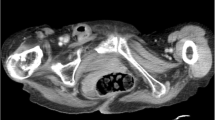Abstract
Hernia sac laparoscopy (laparoscopy through an inguinal hernia sac) is a useful method to evaluate the viability of the self-reduced bowel of incarcerated inguinal hernia that is suspected for strangulation, and avoid unnecessary exploratory laparotomy. On the other hand, peritoneal insufflation for laparoscopy is best avoided in patients with severe chronic obstructive pulmonary disease or poor cardiac output. Here, we describe a 78-year-old male with chronic obstructive pulmonary disease and congestive heart failure, whose incarcerated inguinal hernia self-reduced when he was given spinal anesthesia. Bowel viability was in question, so hernia sac laparoscopy without gas was performed, which allowed us adequate evaluation of the reduced bowel by positioning alone, avoiding both exploratory laparotomy and peritoneal insufflation. In our case, hernia sac laparoscopy under spinal anesthesia without pneumoperitoneum was sufficient to obtain necessary information with minimal surgical stress.

Similar content being viewed by others
References
Sarr MG, Bulkley GB, Zuidema GD. Preoperative recognition of intestinal strangulation obstruction. Prospective evaluation of diagnostic capability. Am J Surg 1983;145:176–182.
Bekoe S. Prospective analysis of the management of incarcerated and strangulated inguinal hernias. Am J Surg 1973;126:665–668.
Wulkan ML, Wiener ES, VanBalen N, Vescio P. Laparoscopy through the open ipsilateral sac to evaluate presence of contralateral hernia. J Pediatr Surg 1996;31:1174–1176.
Binderow SR, Klapper AS, Bufalini B. Hernioscopy: laparoscopy via an inguinal hernia sac. J Laparoendosc Surg 1992;2:229–233.
Al-Naami MY, Al-Shawi JS. The use of laparoscopy to assess viability of slipped content in incarcerated inguinal hernia: a case report. Surg Laparosc Endosc Percutan Tech 2003;13:292–294.
Lavonius MI, Ovaska J. Laparoscopy in the evaluation of the incarcerated mass in groin hernia. Surg Endosc 2000;14:488–489.
Ln E, Wear K, Tiszenkel HI. Planned reduction of incarcerated groin hernias with hernia sac laparoscopy. Surg Endosc 2002;16:936–938.
Chung FF, Chung A, Meier RH, Lautenschlaeger E, Seyone C. Comparison of perioperative mental function after general anaesthesia and spinal anaesthesia with intravenous sedation. Can J Anaesth 1989;36:382–387.
Guvenc BH, Tugay M. Laparoscopic evaluation in incarcerated groin hernia following spontaneous reduction. Ulus Travma Derg 2003;9:143–144.
Author information
Authors and Affiliations
Corresponding author
Rights and permissions
About this article
Cite this article
Takabe, K. Hernia Sac Laparoscopy under Spinal Anesthesia for Evaluation of Reduced Incarcerated Inguinal Hernia. J Gastrointest Surg 11, 1081–1082 (2007). https://doi.org/10.1007/s11605-006-0057-z
Published:
Issue Date:
DOI: https://doi.org/10.1007/s11605-006-0057-z




